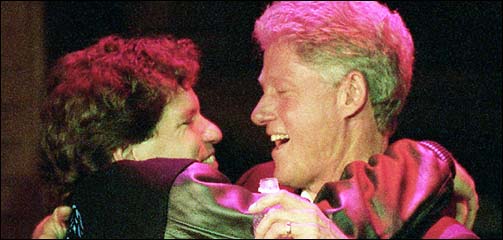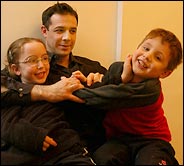| Want to send this page or a link to a friend? Click on mail at the top of this window. |
| Posted February 14, 2004 |
 |
AP |
| Roger Clinton (L) and Bill Clinton. |
| What Runs in the Family Isn't Success |
By EMILY EAKEN |
start with Hollywood — say, the producers Bob and Harvey Weinstein, the filmmakers Joel and Ethan Coen or Peter and Bobby Farrelly, or the actors Ben and Casey Affleck. Move on to the gossip columns, where Paris and Nicky Hilton and Janet and Michael Jackson are recurring fixations. And then consider politics, a field whose most prominent names include George W. and Jeb Bush; John, Robert and Edward Kennedy; and Jerry and Kathleen Brown.
America, a quick survey of some of its most famous citizens suggests, is awash in successful siblings. Most people would hardly find that surprising. Success, it is commonly assumed, runs in families. Fairly or not, power, wealth and fame tend to accrue to members of the same clan, who have a natural interest in keeping their social and material advantages within the bloodline.
But just as celebrities and the superrich turn out to be exceptions to most social rules, says Dalton Conley, a sociologist and director of the Center for Advanced Social Science Research at New York University, they are in stark violation of the norm regarding sibling success. In his new book, "The Pecking Order: Which Siblings Succeed and Why," to be published next month by Pantheon, Mr. Conley turns conventional wisdom on its head, arguing that pronounced economic disparities lie not just between families but within them.
 |
||
AFP |
||
| Gov. Jeb Bush and President Bush. |
His astonishing assertion: differences between families explain only 25 percent of the nation's income inequality; the remaining 75 percent is explained by differences between siblings. More typical of the United States than President Bush and his brother Jeb, the governor of Florida, he suggests, are the White House's previous tenant, Bill Clinton, and his half-brother, Roger, a college dropout, onetime cocaine dealer and failed musician. Or, for that matter, Jimmy Carter and his ne'er-do-well brother, Billy.
"There's this enormous issue of sibling inequality that we sweep under the rug because we want to see the family as a haven in a harsh world, operating outside the dog-eat-dog world of American capitalism," Mr. Conley said over breakfast at a cafe in the West Village, not far from his apartment. "But you can't think of the family in isolation from larger social forces."
His statistics are startling, but he backs them up with a detailed (and occasionally opaque) analysis of three national data sets, including the 1990 United States Census, and 175 interviews with 75 families from around the country. And colleagues who have read his book — or heard him present his findings — are impressed.
 |
| Ren Clement for The New York Times |
| The sociologist Dalton Conley, who has studied slibling differences, with his daughter, E, and son Yo. |
"Before he started on this project, I was quite skeptical," said Michael Hout, a sociologist at the University of California at Berkeley who specializes in social inequality. But he ended up giving the book a favorable review, which will appear in the spring issue of Contexts, a sociology journal.
"What's really innovative and interesting" about Mr. Conley's work, said Judith Stacey, a sociologist at New York University, "is his focus on the family as a source of inequality rather than a respite from it. What he is trying to show is the way in which larger forms of social inequality operate through families and wind up being reproduced."
Just 34, Mr. Conley has acquired a reputation in his field as an original thinker with a knack for poking holes in disciplinary doctrine. His first book, "Being Black, Living in the Red: Race, Wealth, and Social Policy in America" (University of California Press, 1999), based on his prize-winning Ph.D. dissertation, proposed a novel approach to a much-debated conundrum: how to explain lagging black achievement rates in education and employment despite declines in overt discrimination and increasing income equality with whites?
The problem, he argued, was that social scientists were using the wrong data. When researchers compared blacks and whites at the same income level, they found gaps in black achievement. Mr. Conley showed that when data on accumulated net worth were used instead, the achievement gaps disappeared. The obstacle to racial equality, he argued, wasn't just racism but wealth: the typical white family has eight times the assets of the typical black family.
Mr. Conley cites his own family as a case in point. Shy, earnest and boyishly slight, with an endearingly lopsided grin, he grew up on food stamps on Manhattan's Lower East Side, one of the few white kids in a predominantly Latino and black housing project. While many of his peers dropped out of school and ended up in jail, Mr. Conley, the son of bohemian parents who were born middle class, attended some of the best local public schools and went on to a prestigious college and graduate school. His unusual childhood was the subject of his second book, "Honky" (University of California Press, 2000), which he calls "a sociological memoir."
"I'm the exception that proves the rule about race and class," he said.
Now, with his new book on siblings, Mr. Conley is once again challenging some of his field's basic assumptions about inequality. Typical studies of the issue have relied on comparisons of entire households and social groups rather than individual family members. After all, researchers have reasoned, families share genes, resources and a common living environment; how important can sibling differences be, compared with larger social obstacles to economic success like education, race and class?
On the rare occasions when sociologists have looked inside the family, they have tended to chalk up the disparities they have found there to luck — as Christopher Jencks and his colleagues did in the 1972 book "Inequality" — or to measurement error.
For the most part, however, sibling differences have been relegated to the realm of personality and left to psychologists, who have made some intriguing findings. For example, several studies have found that considerable personality differences between siblings remain after traits with clear genetic bases are accounted for, leading some scholars to conclude that siblings are little more alike than people from different families.
This research has prompted a flurry of debate and speculation, including a cottage industry of books and articles trumpeting birth order as the secret to sibling difference. Dating to the 19th-century British eugenicist Sir Francis Galton, who in an 1874 study of leading English scientists noted that a surprising number of them were firstborns, the idea that sibling rank shapes adult personality attained the status of folk wisdom in the late 1990's after Frank J. Sulloway, a historian of science, published the controversial best seller "Born to Rebel: Birth Order, Family Dynamics and Creative Lives" (Pantheon, 1996). Thick with anecdotes, case studies and statistics, the book purported to show the Darwinian logic by which firstborns grow up to be rule-abiding conformists and political leaders, while later-borns become rebellious innovators and revolutionaries.
Birth order research continues to proliferate today, championed as a tool that might help parents predict everything from what position their second-born will play on the football team to the likelihood that he or she will embrace religion or suffer from asthma. More sobering, a number of studies have found a link between birth order, family size and I.Q., suggesting that with each additional sibling there is a corresponding drop in intelligence.
But many of these claims are vigorously disputed. In a recent article in the journal American Psychologist, for example, Joseph Lee Rodgers, a psychologist at the University of Oklahoma, and three colleagues argued that the birth order-I.Q. research was flawed because it was based on comparisons of siblings from different families. When siblings from the same family are compared, the scholars wrote, the correlation disappears. Large families do not produce less intelligent children, Mr. Rodgers and his colleagues concluded. Rather, parents with lower I.Q.'s have tended to have larger families.
Mr. Conley is deeply skeptical of birth order theory, calling it "next after astrological signs as people's favorite folk explanation for why things turn out." But more generally, he argues that personality differences are inadequate to explain disparities in sibling success. "The link between personality and social and economic outcomes is relatively weak in a complex society such as ours," he said. "Take football coaches. You can be reserved and authoritarian like Tom Landry or gregarious like Bill Parcells. Both are successful."
Success, as Mr. Conley defines it, depends on several standard sociological measures: educational attainment, occupational prestige, income and net worth. Because earnings for American workers typically peak between age 45 and 50, he geared his interviews and analysis to siblings in mid-career. And while his conclusions — that everything from parental job loss or divorce to race and family size can affect siblings differently — don't lend themselves to catchy headlines, they arguably provide a more nuanced portrait of internal family dynamics than all-purpose explanations like birth order.
Some of his more provocative findings concern middle-borns. In families with three or more children, Mr. Conley says, middle offspring are less likely to receive financial support for their education and may do less well in school than their older and younger siblings. The chances that a second child will attend private school drop by 25 percent with the birth of a third, Mr. Conley found, and the likelihood that he or she will be held back a year increased severalfold. Unlike typical first- and last-borns, he reasons, middle children never experience family life as an only child; instead, they are forced to compete with their siblings for money and attention. (In this sense, he concedes, birth order does matter: not as a psychological variable but as a constraint on family resources.)
Other findings seem to confirm common-sense intuitions. According to Mr. Conley's analysis, for example, women are more likely to be as successful as their brothers if their mothers worked outside the home. And, like the long-suffering George Bailey in "It's a Wonderful Life," the oldest child still at home at the time of a parental death or divorce is more likely than younger siblings to endure negative socioeconomic consequences as a result. Brothers and sisters may even experience race differently, he argues, since skin color can vary considerably within the same family.
In the end, the intricacy of Mr. Conley's analysis can almost seem a liability. "The Pecking Order" is so stocked with case studies and theoretical assertions that it is tempting to conclude that there may be nearly as many factors affecting sibling success as there are siblings in the world.
But Mr. Conley has a ready defense. "Anyone who's going to sell you on one variable is selling you a bottle of snake oil," he said. "Families and societies are just too complex for that."
However complicated, he added, his research has practical implications for parents. For example, thanks in part to his findings on middle-borns, he said, he was no longer considering having a third child.
"I've got one of each sex," he said. "I'm satisfied with two."
Copyright 2004 The New York Times Company. Reprinted from The New York Times, Arts & Ideas, of Saturday, February 14, 2004.
| Wehaitians.com, the scholarly journal of democracy and human rights |
| More from wehaitians.com |